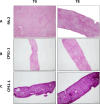Normothermic Machine Perfusion of Explanted Human Metabolic Livers: A Proof of Concept for Studying Inborn Errors of Metabolism
- PMID: 40026238
- PMCID: PMC11874047
- DOI: 10.1002/jimd.70010
Normothermic Machine Perfusion of Explanted Human Metabolic Livers: A Proof of Concept for Studying Inborn Errors of Metabolism
Abstract
The human liver plays a central metabolic role; however, its physiology may become imbalanced in inborn errors of metabolism (IEM), a broad category of monogenic disorders. Liver transplantation has been increasingly used to improve patient metabolic control, especially in diseases related to amino acid metabolism, such as urea cycle disorders and organic acidurias, to provide enzyme replacement. Ex vivo liver normothermic machine perfusion (NMP) techniques have recently been developed to increase the number of transplantable grafts and improve transplantation outcomes. This study used seven NMP of explanted livers from patients with IEM undergoing transplantation as models to investigate disease-related liver metabolism and function. The perfused livers demonstrated positive viability indicators and disease-specific targeted metabolomics providing the proof-of-principle that our ex vivo model expresses the biochemical disease characteristics and responds to therapeutical intervention in a unique "physiological" milieu, offering an ideal tool to study novel treatments, in a setting closely mirroring human disease.
Keywords: machine perfusion; metabolic liver disease; pediatric liver transplantation.
© 2025 The Author(s). Journal of Inherited Metabolic Disease published by John Wiley & Sons Ltd on behalf of SSIEM.
Conflict of interest statement
The authors declare no conflicts of interest.
Figures






References
MeSH terms
Grants and funding
LinkOut - more resources
Full Text Sources
Medical

